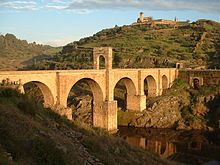PART 2: Balboa Park and the Panama Canal Exposition Then and Now

The bridge from Laurel into the Park from 6th is reminiscent of the Tagus River Bridge in Alcantra, Spain.
Nancy Carol Carter’s February talk gave many fascinating details about the Exposition of 100 years ago. The United States planned this exposition to celebrate the opening of the Panama Canal. The canal would allow boats to travel between the Atlantic to the Pacific Oceans. The United States had money to donate to the host city. New Orleans, San Francisco and San Diego were all contenders. Since San Francisco was still recovering from the 1906 earthquake and fire and had a larger population, that’s where the money went. However, San Diego’s citizens recognized that ours was the first port after the canal. The citizens of San Diego raised enough money to finance their own exposition, the 1915 “Garden Fair.” At this time, cattle still grazed on portions of the land, and various charitable organizations had made their marks as well.
In 1905 the city voted to devote a “bit of property tax” for a Park Fund which would finance park development. They appointed a committee to oversee the park’s improvement. Meanwhile, people were in Panama, working on the canal and dying. From 1881 until 1894 there were 22,000 deaths of French workers at a cost of $287.000.000. Thanks to a vaccine and the use of DDT between 1904 and 1914 the United States saw only 5,600 deaths and a cost of $375,000,000. The “First Port of Call” for ships coming from the Panama Canal was San Diego. The newspapers advertised it. In that late Edwardian period, seminude models helped to call attention to it.
By 1909 there was poor public transportation and poor infrastructure in San Diego. “City Park,” as it was still called, was “only modestly improved,” Carter told us. San Francisco had 416,912 inhabitants, Los Angeles had 319,198. San Diego had a population of fewer than 40,000. Nevertheless, the Panama-California Exposition Company was formed with U.S. Grant, Jr presiding, John D. Spreckels as Vice President and D. C. Collier as Director-General. In 1910 the company encouraged a change in the name “City Park” to Balboa Park honoring the Spanish explorer who had first seen the Pacific Ocean.
The Exposition’s Ground Breaking took place in July, 1911 and was a huge production lasting four days with a carnival, a Catholic Mass in the Park, a parade for every possible situation, elaborate floats including one consisting of all flowers. The Park was still not quite a dream.
Fulfilling the dream grew more complicated. The Olmsted Brothers’ father had designed Central Park. San Diego hired the sons, but sadly, they quit after a year. They wanted the Exhibition’s site to be just north of San Diego High, at the edge of the park. However, the city officials liked the central Mesa feeling it could accommodate more people. The Olmsteds took their pencils and went home. Bertram Goodhue became the architect. The city raised $1,000,000.00 for park improvements. Not only did they supply their own funding, the San Diegans also donated plants and cuttings. They knew what would grow and how to encourage those plants. Kate Sessions applauded this. Between Kate Sessions’ planting early so the plants would be established by the date of the Exposition and the residents’ donations of fully grown trees and plants, the Park looked as it had been envisioned.
The park’s first rose garden came from John Morley and Paul Thiene who established the Ramona Nursery. He took over from the Olmsteds’ Nursery Supervisor. Thiene became supervisor of Landscape. Carter calls Paul Thiene and Frank Allen, Jr. the “accidental landscapers.” They both profited from the Olmsteds’ retreat. Frank Allen was actually trained as an architect and left “‘an indelible imprint on the architecture and landscape’ of San Diego.”
The Exposition buildings took their inspiration from Spain and Mexico. The bridge from Laurel into the Park from 6th is reminiscent of the Tagus River Bridge in Alcantra, Spain. The California Building looks much like the church in Taxco.
The Exhibition was a success. Its temporary buildings have been replaced or retrofitted; the Exposition did not stop for World War I. Nancy Carter gave me new respect for the Park, its buildings, its landscape and for our city.
There will be no meetings in July or August. The next meeting will be held at 4070 Jackdaw on September 23 from 6 p.m. until 8 p.m. The topic will be announced.
Category: Local News







